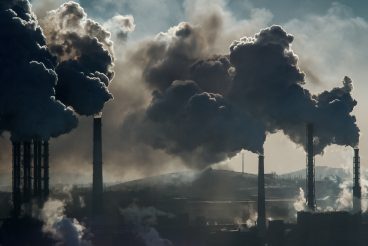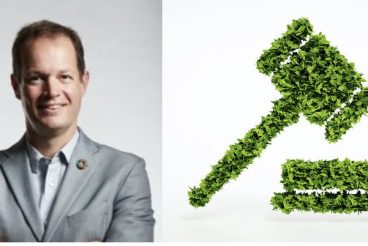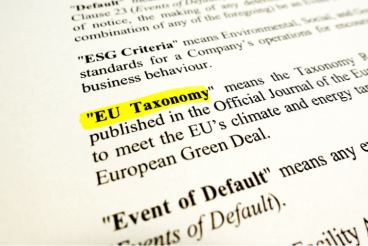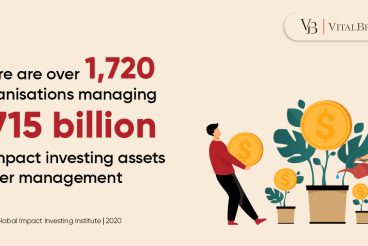Despite the focus on efforts to mitigate global warming and its impact, a critical barrier to more effective action remains poor understanding of highly complex climate systems, says EY’s Mike Zehetmayr. But, he argues, technology can play a key role, from monitoring systems for greenhouse gas emissions that are already available today to the future promise of carbon capture and storage.

Failure to understand the complexities of climate systems, lack of the data necessary to determine the precise impact on global warming of specific human activities and organisations, and the risk of “disclosure fatigue” are all factors impeding an effective response to climate change by the financial services industry and the wider business community, according to Mike Zehetmayr, EY’s financial services sustainability data and technology leader for Europe, the Middle East, India and Africa.
Zehetmayr brings a different perspective to climate issues from most people in the financial services industry. As a fellow of Britain’s Royal Geographical Society, he began his career as a physical geographer studying glaciers in the Arctic.
It’s an unusual background, he acknowledges: “Generally, financial services is not an industry scientists tend to work in. But I believe it offers the opportunity to make a huge impact in society through the responsible allocation of funding and liquidity. I’ve ended up doing something I wanted to do 30 years ago: connecting environmental science and the impact of decision-making in financial services.”
Zehetmayr believes the debate over remarks by HSBC’s – now suspended – head of responsible investment, that climate change was not a financial risk about which the bank should worry, has illustrated a widespread lack of awareness that climate change involves complex natural and environmental systems that react to its impact.
“These systems are interlinked,” he says. “When one is affected by human activity, the other must adapt, which has a cascading effect through the entire system and impacts how it behaves going forward. Adaption tends to be gradual in terms of human time horizons, but we can see evidence in environmental records that – as with human systems – nature-based systems have tipping points and can change from one state to another. Some environmental changes have been very rapid, over tens rather than hundreds of years.”
Resilience Engineering

He adds: “There’s a concept known as resilience engineering that applies particularly to sectors such as the nuclear or airline industries, where the impact of something going wrong is very significant. It looks at how you anticipate, monitor, learn from and adapt a system to reduce the risk or impact of failure. The same thing applies to nature-based or environmental systems, and we need to follow the same principles. The key difference is that these are not systems humans have designed and can currently fully monitor or anticipate the result of adaptions we – or the environmental system – make, so the risk and impact can’t be fully described.
“For the majority of people living in temperate climates, the impact of climate change is only just starting to be felt – most humans don’t live in environmentally sensitive regions like the Arctic or sub-Saharan Africa. This was very apparent in the recent COP26 conference where, for example, one of my colleagues struggled to fully appreciate the level of anger and concern a native leader from Greenland held.
“I explained, ‘You have to realise that this man, probably in his late 40s or early 50s, has spent his whole life dealing with the impact of climate change, like his parents before him. Their society and social norms, how they live, have been hugely impacted. They are already experiencing what we will experience in the future – they are experiencing climate change happening now.’”
Most people today lack the experience of seeing the impact personally, Zehetmayr says. Meanwhile, the limitations of current data and models available mean many climate modellers are struggling to quantify the impact of climate change within a complex environment. Taking this a step further to the financial services sector, the level of detail needed for underwriting and investment decision-making far exceeds current levels: “We must continue to invest in raw data and modelling to support the commitments made at COP26 to redirect capital to adapt and mitigate climate change.”
He says it’s interesting to note that in 1990 the United Nations’ Intergovernmental Panel on Climate Change was able to forecast accurately the level of climate change we are experiencing today. “They did this based on how human society would continue to emit greenhouse gases, which in their view – correctly – would be very accurate,” Zehetmayr says. “Climate scientists called it right 30 years ago and their forecasts for the next 70 years should be listened to now. We must adapt and learn from the last 50 years of climate and environmental change.
Cascading Impacts
“People in financial services ask exactly what the impact is going to be. But we don’t know because it’s a complex set of levers that will have cascading impacts through that environmental – and then financial – system. Scientists can forecast according to different temperature pathways, and look at what may happen at a specific geographic location or to a specific economic asset, but the only thing they can say for sure is that there is no question human activity is having an impact on the environment around us.”
As society adapts to the changing environment, humans will invest in mitigating the impact, and examine how this interplays with different vulnerabilities and the impact of different climate or environmental hazards. Zehetmayr says: “We can also look at how the different risks arising from temperature pathways are felt by humans and impact economic activities and investments.
“There’s no doubt that the planet and its environment will adapt, but there will be a cost. The question we have to ask ourselves is how much of an impact are we as individuals and our society prepared to accept now and for future generations? How do I advise my clients to start looking at that complex end-to-end system and about their role within that, and their choices at a personal and professional level as they invest capital or own assets?”
Zehetmayr points to the jet stream in the northern hemisphere and its impact on weather in the UK and western Europe. “It’s been very obvious over the past decade that because of the albedo effect [the ability of surfaces to reflect sunlight or heat from the sun] in the Arctic, changes to the polar vortex in the stratosphere above the Arctic are impacting the power of the northern jet stream, causing the flow of air to become more sinuous.
“This is resulting in the weather systems in western Europe flip-flopping between two environmental states, wet and dry. In the UK, for instance, we are moving to a climatic pattern where we will experience higher and more intense periods of rain in the winter as the atmosphere warms, and drier summers. The UK Environment Agency’s third report on climate change states that we will see a 22% reduction in summer rainfall and a 13% increase in winter rainfall by the 2080s. Four million people and £200bn of assets will be at risk from flooding and sea level rise. Understanding these changes arising from scientific research into these complex environmental systems is critical not just to investment and financial decisions, but to wider society as well.”
Analysis of the ice record in Greenland and Antarctica makes it possible to determine the constitution of the Earth’s atmosphere from as long as 600,000 years ago, he notes. “It shows us that tipping points, where the environment changes from one state to another, can take place in as little as 30 to 40 years,” he says. “Today we don’t fully understand the impact human activities are having on that complex system, so we have to make a risk-based decision. Is that decision aligned with us as individuals, or with the purpose of our organisation?

Risk-Based Decisions
“It’s not just about an extra 30 centimetres in sea level rise by 2030, but a series of events – for example, flooding in low-lying countries, as we already see in areas of Polynesia and the Indian Ocean, where islands are becoming unliveable as a result of sea level rise, storm intensity and rainfall.”
This affects asset allocation and lending decisions over the next 10-year horizon, he says. “We are already starting to see weather events that are impacting investments, and that affect possible mitigating action we should be taking to protect investments. But there is a lack of understanding that with a complex system, we can’t answer all the questions. So people must take risk-based decisions.”
An important element of the response by political and financial authorities is to create mechanisms to determine the extent to which business activities contribute, or not, to greenhouse gas emissions. Says Zehetmayr: “To make an informed risk-based decision you need access to high-quality, comparable data. Policy makers, regulators and private organisations all recognise this and are defining disclosure metrics and methodologies to support this transparency.
“The challenge that needs to be addressed is that many companies are struggling to understand what is important to disclose, how data will be used, and the volume of new types of data they will need to process and manage both as a producer and consumer of sustainability data. But what’s not been focused on is the ‘how’ of what data gets generated and shared at scale.”
Disclosure Fatigue
He points to the example of a fintech firm that received three, 70-page ESG disclosure surveys from lenders or investors requesting similar but different sustainability data – with the likelihood that similar but not identical requests will follow in the future.
Meanwhile, different types of institution fulfil various roles and will require access to different information relevant to that role. For example, a bank can request information not in the public domain, such as plans to invest in climate adaption and transition, that cannot be made available to asset owners such as pension funds as this could be deemed a forward financial forecast and therefore forward-looking information that should be made available to all investors.
Says Zehetmayr: “You need to understand the distinction between the roles of finance providers to ensure that certain information can be shared. You can’t just rely on public information. There must be a mechanism to provide commercially sensitive or strategic information that needs to be kept private, but still needs to be aligned with the public information that you’re providing.”
He says that complexity is not being adequately addressed amid an alphabet soup of voluntary standards and, increasingly, regulatory requirements. “We haven’t really resolved the problem of sharing that information at scale, including a mechanism to share commercially sensitive information. There are models that we need to learn from, such as the concept of legal entity identifiers”, developed in response to the 2007-09 financial crisis as a global system to identify counter-parties to financial transactions.
Unless the issue is resolved, Zehetmayr warns, ‘disclosure fatigue’ could set in. “We could get to a point where it is being argued that it is too complicated and expensive. I know one FTSE 100 group that has more than 40 people whose sole job is to deal with inbound environmental reporting requests and share information. That’s not sustainable in the long term from a cost perspective, and you will get inconsistencies around the data. But organisations currently don’t have many options.”
Granular Information
The second issue is how to monitor emissions throughout the length of global supply chains. “That is problematic, because but we don’t have monitoring processes embedded into them,” he says. “We do have quite sophisticated proxy assessments used by some rating and scoring agencies for different types of activity within the supply chain, using comparisons that offer estimates with a reasonable level of confidence.
“That’s not a bad starting point to inform decision-making, but it’s not quite the right answer, which is to start actually capturing and monitoring the data. One of the good things to come out of the carbon offset market – and I know that opinions differ about whether that’s a good or bad thing – is that to create an offset, or remove carbon from the atmosphere through sequestration, you have to provide evidence – market forces require that for pricing and trading.
“Firms will also need to industrialise monitoring and use IoT devices to obtain granular information on greenhouse gas emissions over time, and the technology already exists today. We are starting to see this in things like new housing developments that incorporate electric vehicle chargers, which will enable monitoring of vehicles’ electricity consumption, or heat pumps”.
Zehetmayr says that while the systematising and embedding of technology is underway, implementing the monitoring of complex supply chains will require time – “but it will happen, particularly with the shift to using electricity for industrial processes or transportation”.
Carbon Sequestration
Carbon sequestration is a complex issue that remains poorly understood, he notes. “The technology remains emergent and still unproven at industrial scale. The challenge is how long it is to be sequestered for? Do you have evidence for it? But offsets are even more challenging. People talk about planting trees, but a growing oak tree doesn’t sequester carbon very fast. The carbon footprint of a return flight to Bangalore, 2.4 tonnes, takes about 12 or 13 years for an oak tree to sequester.
“Everybody focuses on the Amazon, which we urgently need to protect as a biodiversity hub, but the boreal forest at the edge of the Arctic tundra is actually the world’s biggest forest. Yet the most important source of carbon sequestration is the world’s oceans, particularly the ocean floor, followed by soil, then vegetation and forests. While we can use satellite imagery to examine rainforest canopy intensity, we have a relatively short record, probably only about 20 years, of the health of these ecosystems and whether or not they are capturing that carbon and storing it.
“We also have to change agricultural practices in both developed and developing worlds to protect the health of soil, improve the capture of carbon and reduce the release of carbon and other gases. Another area to explore in terms of carbon release is permafrost, which is already melting.”
While scientists generally agree that the Paris Agreement ceiling of 1.5ºC of global warming is almost certain to be exceeded – quite possibly before the end of this decade – Zehetmayr believes it remains a necessary benchmark. “If we just throw our hands up in the air and say we can’t do it, I believe that as a society we are accepting, both personally and professionally, that we are going to continue with activities that will lead to a very uncertain future for humans.”
— — —
Mike Zehetmayr is a financial services partner at EY, and currently leads the firm’s sustainability data and technology practice across EMEIA (Europe, the Middle East, India and Africa). He is an experienced management consultant providing advice and delivery of technology and business change programmes covering strategy, operations and technology change. Mike is a Fellow of Royal Geographical Society, and began his career as a physical geographer studying glaciers in the Arctic.





